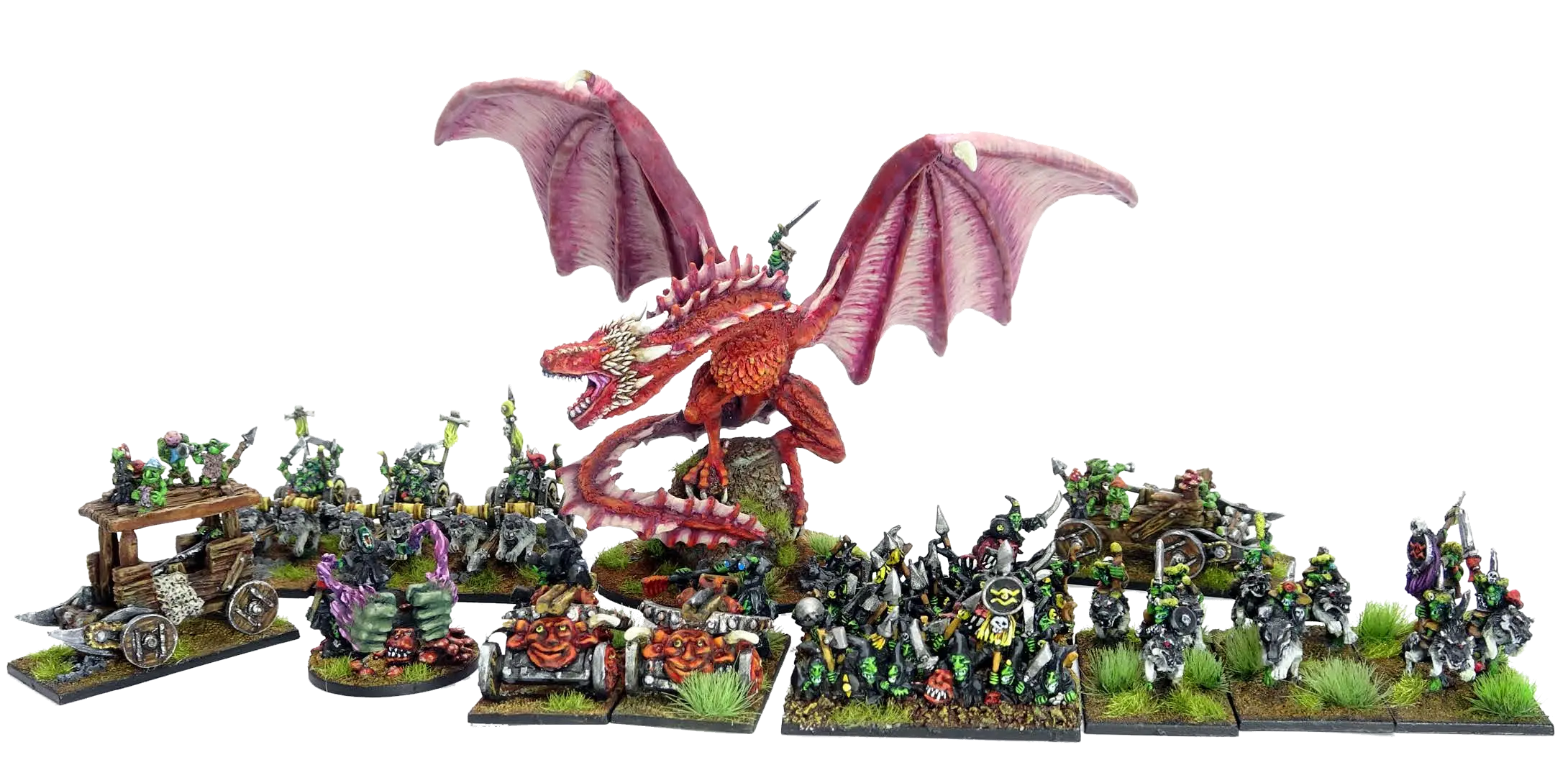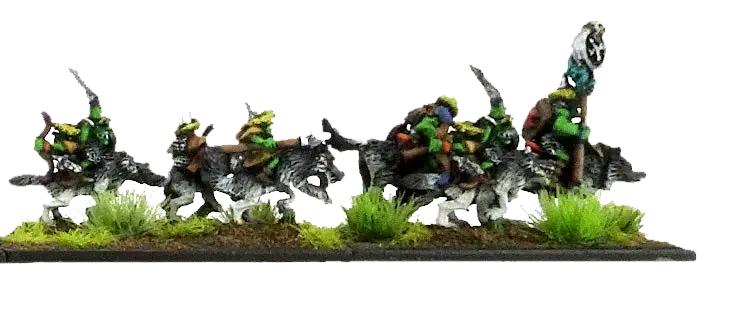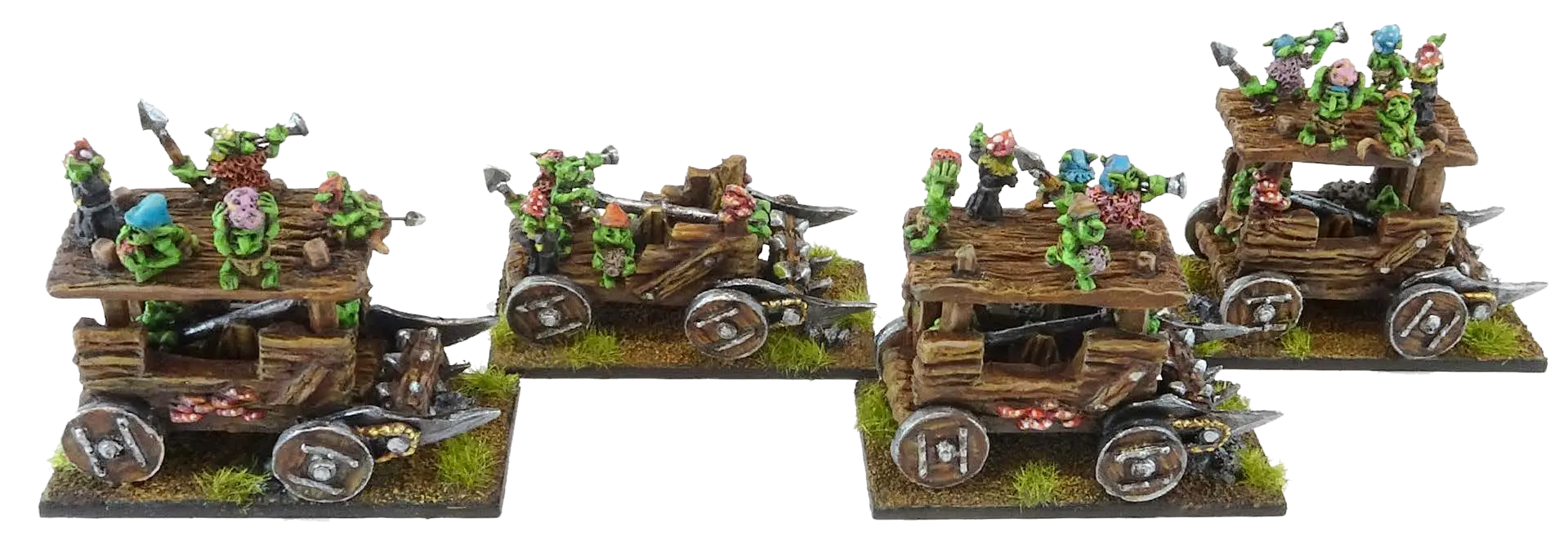Goblins
 Goblins are small, green, vicious, mean-spirited and generally
unpleasant creatures. Clues as to their character may
be discerned in their tiny pointed teeth, beady glinting eyes,
scrawny grasping hands and general demeanour of a whipped
dog.
Goblins are small, green, vicious, mean-spirited and generally
unpleasant creatures. Clues as to their character may
be discerned in their tiny pointed teeth, beady glinting eyes,
scrawny grasping hands and general demeanour of a whipped
dog.
To give them their due, Goblins are prolific. There are lots of them and no matter how many die or run away, there are always plenty left. Their preferred method of fighting is to shoot their enemy in the back from a good distance. They are half-way decent shots but in other respects are poor and often unwilling fighters. However, they are dangerous in large numbers and quite capable of overwhelming far better troops by sheer weight of numbers.
Like all greenskins, Goblins are quarrelsome and fractious. They fight amongst themselves both on and off the battlefield. They feel little sense of loyalty to their own kind let alone anyone else, and will cheerfully maim, kill and even eat their comrades if they can get away with it.
Goblins are generally recognised as belonging to two main breeds, namely Common Goblins and Night Goblins. These types are not physically different to each other, although all kinds of Goblin are liable to extreme variations in size, so it is quite usual for a mob of Goblins to include some individuals as much as twice the size of others. In this respect, where a big Snotling becomes a Goblin and vice versa is debatable, though from an Orc’s point of view it hardly matters as they’re all there to be bossed about.
The majority of Goblins living in open areas, most notably in the Badlands and Dark Lands, are Common Goblins or just ordinary Gobbos. They are as common as muck throughout the hills, valleys and plains of the Old World and beyond. We quite cheerfully refer to all the different kinds of Goblins as Goblins, but where this might prove confusing we call ordinary Common Goblins just that … Common Goblins. And ain’t they just!
Common Goblins ride Giant Wolves much as humans ride horses. Not only are these large and dangerous creatures ridden by individual Goblins, but chariots and carts may be pulled by several Giant Wolves harnessed together. Giant Wolves are vicious creatures with slavering fangs and sharp claws, quite often more dangerous than their Goblin riders. They are faster than horses too.
Goblin Wolf Riders commonly raid and pillage ahead of advancing Goblin hordes, scouring the countryside for signs of enemy troop movements. On the battlefield they harry the flanks of enemy units and chase down those who’ve fled braver greenskins.
Night Goblins are adapted to life underground where they subsist on fungi, cave squigs, beetles and bits of each other. They live under the mountains throughout the Old World and Southlands in tunnels and caverns that are cool and dark. Night Goblins have a strong aversion to daylight and when forced above ground wear black or very dark enveloping robes to protect themselves from the sun’s rays.

Goblin army selector
| Troop | Type | Attacks | Hits | Armour | Command | Unit size | Points per unit | Min/max | Special |
|---|---|---|---|---|---|---|---|---|---|
Goblins |
Infantry |
2/1 |
3 |
– |
– |
3 |
30 |
4/– |
|
Squig Herd |
Infantry |
3 |
3 |
– |
– |
3 |
30 |
–/– |
– |
Trolls |
Infantry |
5 |
3 |
5+ |
– |
3 |
110 |
–/4 |
|
Wolf Riders |
Cavalry |
2/1 |
3 |
6+ |
– |
3 |
60 |
2/– |
|
Wolf Chariots |
Chariot |
3 |
3 |
6+ |
– |
3 |
75 |
–/4 |
– |
Pump Wagon |
Chariot |
D6 |
3 |
5+ |
– |
1 |
50 |
–/2 |
|
Giant |
Monster |
8 |
8 |
5+ |
– |
1 |
135 |
–/1 |
|
Doom Diver |
Artillery |
1/3 |
2 |
– |
– |
2 |
80 |
–/1 |
|
Spear Chukka |
Artillery |
1/2 |
2 |
– |
– |
2 |
65 |
–/2 |
|
|
|||||||||
Goblin Warboss |
General |
+1 |
– |
– |
8 |
1 |
80 |
1 |
– |
Goblin Hero |
Hero |
+1 |
– |
– |
7 |
1 |
45 |
–/4 |
– |
Goblin Shaman |
Wizard |
+0 |
– |
– |
6 |
1 |
30 |
–/2 |
– |
Wolf Chariot |
Chariot mount |
+1 |
– |
– |
– |
– |
+10 |
–/1 |
|
Wyvern |
Monstrous mount |
+2 |
– |
– |
– |
– |
+80 |
–/1 |
Special rules
- 1. Goblins
-
A Goblin unit is allowed to shoot as if it had bows but its range is reduced to 15cm.
Up to two units per full 1000 points can be replaced by Squig Herds while still counting for the Goblin min/max value.
- 2. Trolls
-
When trying to issue an order to a unit of Trolls or to a brigade that contains a unit of Trolls, any Command penalty applied for distance between the character and the Troll unit is always doubled. So at 20cm no penalty applies, at 40cm −2, at 60cm −4, and so on.
Trolls can regenerate wounds – in each round of combat after whole stands have been removed Trolls automatically regenerate one outstanding hit. If no hits are left over after removing whole stands then regeneration has no effect. Regenerated hits still count towards the combat result for the round.
- 3. Wolf Riders
-
The Wolf Riders have a shooting range of 15cm and 360° vision – stands in this unit can draw line of sight from all edges for the purpose of evading and shooting, including shooting at charging enemies. Note that this unit still needs Line of Sight from its front edge to charge an enemy.
- 4. Pump Wagon
-
The Pump Wagon doesn’t move in the Command phase by initiative or by successful orders. Instead it always moves once up to 1D6 × 10cm. This move is automatic, requires no Command roll, and happens at any time during the Command phase but may not interrupt a character giving orders or units moving (including other Pump Wagons). This gives the Pump Wagon a movement of between 10cm and 60cm each turn.
In the combat phase a Pump Wagon deals D6 attacks. This is in addition to any attack bonuses for charging enemy in the open and for being a chariot. When charged or after retreating as a result of combat, its attacks are halved to D3. Roll to determine the number of attacks an every round of combat.
A Pump Wagon cannot be driven back by shooting and does not roll for drive backs. Pump Wagons ignore confusion. A Pump Wagon cannot be brigaded with other units; not even another Pump Wagons, and characters cannot join it.
The enemy does not gain Victory points for a destroyed Pump Wagon and a Pump Wagon does not count towards the Goblin army’s break value in any way.
- 5. Giant
-
Giants must always be given a separate order. They cannot be brigaded with other troops, although several Giants can be brigaded together if you so wish. If you attempt to give an order to a Giant and fail then you must take a test to see what it does. Ignore potential blunders – these are taken into account by the following rules. Roll a dice and consult the Giant Goes Wild chart. Where Giants are brigaded together roll for each separately.
Giants have a great many hits, 8 in fact, which are almost impossible to inflict during even a fairly lengthy combat engagement. Because Giants have so many hits we must consider the possibility of hurting the Giant and reducing its effectiveness in subsequent turns. Therefore, if a Giant has accumulated 5–7 hits by the end of the Shooting phase or Combat phase and is no longer engaged in combat it is deemed to have been badly hurt. Once a Giant is badly hurt all accumulated hits are discounted and its maximum Hits value and Attacks are halved for the rest of the battle (to 4 Hits and 4 Attacks).
A Giant causes terror in its enemies.
- 6. Doom Diver
-
The Doom Diver has a range of 60cm and a unit hit by a Doom Diver is allowed to make its normal armour save.
Doom Divers shoot at such a high trajectory that they cannot shoot at charging enemies.
- 7. Spear Chukka
-
The Spear Chukka is a Bolt Thrower.
- 8. Wolf Chariot
-
Any character can ride a Wolf Chariot.
The character riding a chariot adds +1 to his Attacks.
- 9. Wyvern
-
Any characters may ride a Wyvern.
A Wyvern can fly increasing its rider’s movement from 60cm to 100cm, and it adds +2 Attacks to those of its rider.
A unit that includes a Wyvern rider causes terror in its enemies.

Goblin spells
Mork Save Uz!
5+ to cast Range 30cm
The Shaman summons the power of Mork to protect the greenskins from the enemy.
This spell can be cast on any friendly unit within 30cm of the Shaman. The unit gains a 5+ save worked out in the usual manner until the beginning of their next turn. If the unit already has a saving roll then it can choose which one to make, but may not take both.
Gerroff!!!
5+ to cast Range 60cm
The voice of Gork booms out across the battlefield driving back his foes with a rancid gale force yell.
This spell can be cast on any unengaged enemy unit within range regardless of whether the Shaman can see it or not. The spell cannot be cast on a unit engaged in combat.
The enemy unit is driven back 1D6 × 5cm towards its own table edge. This is treated in the same way as a drive back from shooting, except that the direction is established by determining the shortest route to the table edge. A unit cannot be routed by a drive back from a Gerroff spell. If the unit leaves the table edge it must roll as described in the main Warmaster rules.
Brain Busta
5+ to cast Range 30cm
A fearsome bolt of pure Waaagh! energy issues from the Shaman’s outstretched hand and strikes an enemy unit.
The Shaman must be able to see his target to use this spell and it cannot be directed at a unit engaged in combat. Brain Busta is treated like three ordinary shooting attacks except that armour saves have no effect (all targets count as having no armour). A unit can be driven back by Brain Busta as with ordinary shooting.
Waaagh!
4+ to cast Range 30cm
The shaman summons the power of the mighty Waaagh! to invigorate the greenskins.
This spell can be cast on a friendly unit of Goblins engaged in combat; including Squig Herds, Wolf Riders, Wolf Chariots and Pump Wagons but not Trolls, Giants or other non-greenskins. The spell can be cast regardless of whether the Shaman can see the target or not.
The spell lasts for the duration of the following Combat phase. Every stand in the unit, including characters that have joined the unit, adds +1 to its Attacks value.
